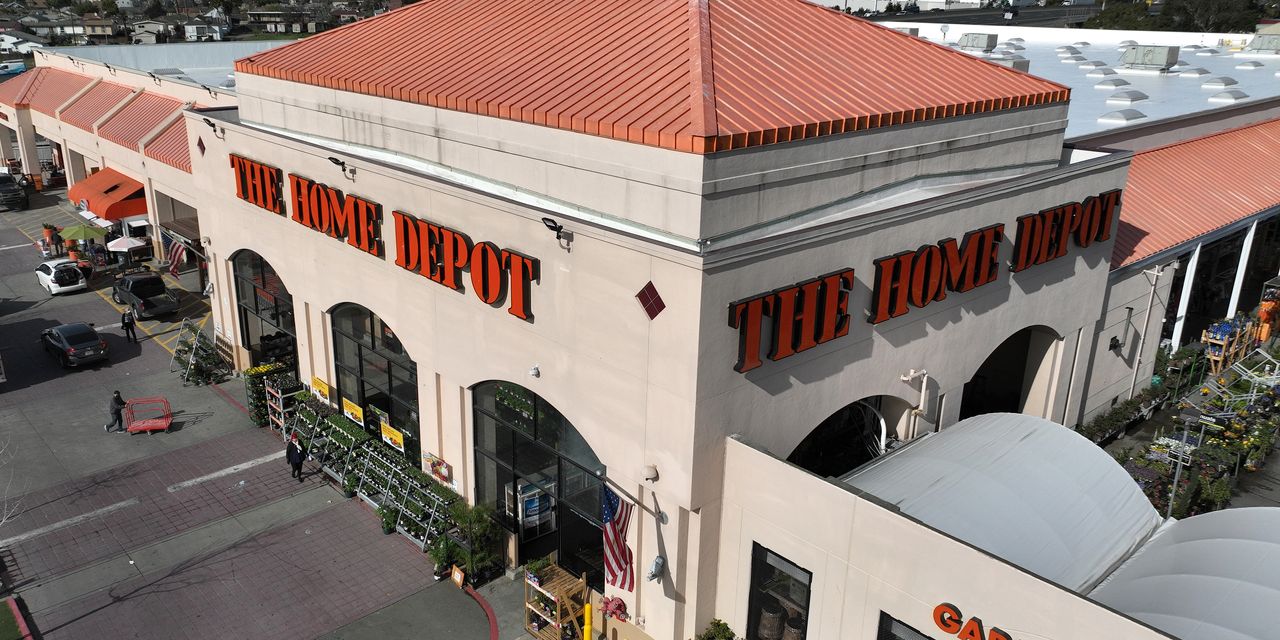Home Depot launched a $15 billion stock buyback program after beating second-quarter expectations. However, the home-improvement retailer warned that shoppers are still cautious of spending on big-ticket items and it expects a sales decline this year.
Home Depot
(ticker: HD) on Tuesday reported earnings of $4.65 a share for the second quarter, down from $5.05 for the same period a year earlier. Sales fell 2% to $42.9 billion from a year ago.
Analysts had expected a profit of $4.45 a share on revenue of $42.2 billion, according to consensus estimates from FactSet. Same-store sales, a measure of revenue growth in stores open for at least a year, fell 2%, better than a projected decline of 3.9%.
The company authorized a new $15 billion share-repurchase program, replacing its previous buyback plan.
“While there was strength in categories associated with smaller projects, we did see continued pressure in certain big-ticket, discretionary categories,” CEO Ted Decker said in a company statement.
D.A. Davidson analyst Michael Baker wrote the results were “good enough.” The quarterly improvements in same-store sales suggest that the business is recovering.
“Overall, while some near-term bulls may have wanted a bigger beat, we think these results are good enough to sustain the recent rally in HD shares,” Baker wrote in a note to clients. Although the stock is up just 4.5% this year as of Monday’s close, it has gained a little over 15% in May alone. He rates Home Depot stock at Neutral with a $290 price target.
Decker said the company remains positive on the medium-to-long term outlook for home improvement and its ability to grow share in a fragmented market.
Home Depot reiterated its guidance for sales and comparable sales to fall 2% to 5% from the previous year, and for earnings per share to slip 7% to 13%. Management lowered its financial forecasts for the fiscal year ending in January when it reported first-quarter results, which helped reset expectations. The company reiterated the forecast at a June investor day.
“Some might be disappointed by keeping the guidance unchanged despite the 20 cents beat on earnings per share, and the better-than-expected comps,” wrote Evercore ISI analyst Greg Melich in a note to clients. “That said, with continued pressure in certain big-ticket, discretionary categories, HD took the conservative approach.” Melich rates Home Depot stock at Outperform with a $355 price target.
Margins contracted by eight basis points, or 0.08 percentage points, in the quarter, driven by pressure from inventory shrink, the term retailers use to refer to losses of product driven by theft, damage, and administrative errors.
“We are certainly in a battle in retail as we kind of think about shrink, but we’ve always continued to lean into initiatives that we’ve seen that can have impact to mitigate overall,” said Ann-Marie Campbell, Home Depot executive vice president of U.S. stores and international operations.
Home Depot stock ticked up 0.2% to $330.58 on Tuesday.
This is a year of “moderating demand,” Home Depot’s management team said in a call with investors Tuesday. The housing market is making a sluggish recovery, with higher interest rates keeping potential buyers on the sidelines. Add in the effects of inflation, and people are less eager to invest in home-improvement projects, wrote Wedbush analyst Seth Basham. Harvard’s Leading Indicator of Remodeling Activity predicts that annual expenditures for home improvement will decline at an “accelerating rate” through the first half of 2024.
“The ongoing reductions in household moves will cause a decline in the remodeling and repair activity that typically occurs around the time of a home sale,” said Carlos Martín, project director of the remodeling futures program, in a July press release. “The magnitude of the impact may be offset if owners who are locked into their current homes with ultra-low mortgage rates continue to renovate to meet changing needs or take advantage of new federal incentives for energy-efficiency retrofits.”
Results from other companies in the home-improvement sector paint a similar picture for softer consumer demand in North America.
Floor & Decor
‘s (FND) management cut its forecasts for the fiscal year,
Masco
(MAS) said North American plumbing demand is “soft,” and
Whirlpool
(WHR) noted that appliance demand in the second quarter was flat.
Some of these companies reported stronger demand in their professional businesses, which cater to contractors, than in the do-it-yourself sector. Home Depot reported a similar trend, with Pro sales outperforming DIY this quarter. But even that positive factor may be fading this year. The company said that Pro sales performance was “slightly negative” this quarter, as backlogs for Pro orders start to decrease.
Home Depot’s numbers may offer clues about the outlook for other gigantic retailers. While some smaller chains have disclosed numbers, Home Depot is the first of the big-box stores to do so.
Target
(TGT),
Walmart
(WMT), and Lowe’s (
LOW
) will follow in the next two weeks.
Home Depot’s results often have a bigger read-through to Lowe’s results next week. Home Depot’s same-store sales improvement suggests Lowe’s may also see an improvement in same-store sales, Baker wrote.
Analyst sentiment has grown more cautious on the shares in recent months. As of Monday, 54% of analysts rated the shares at Buy, down from 71% last August. The number of Hold ratings, meanwhile ticked up to 43% from 29% a year ago. Three percent of analysts rate the stock at Underweight or Sell.
The low number of Sell ratings suggest that Wall Street is still upbeat on the stock in the long run.
Write to Sabrina Escobar at [email protected]
Read the full article here



